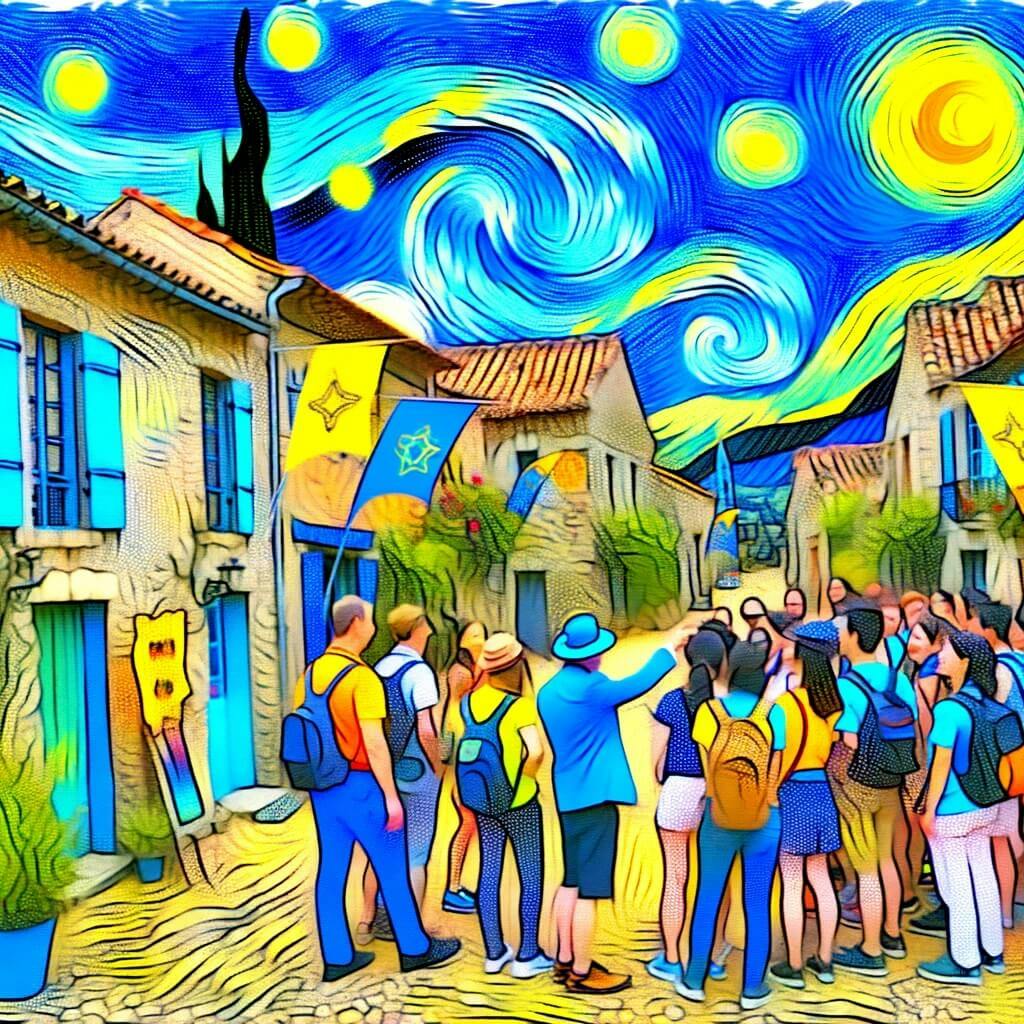Imagine the moment your toes first touch the warm sand of a faraway beach. The salty breeze carries the scent of exotic flowers and the rhythmic crash of the ocean lulls you into a state of pure bliss. Nearby, the vibrant stalls of a bustling market beckon, alive with the chatter of locals bartering for colorful fabrics and handcrafted treasures. This is the transformative power of travel – the ability to step outside your daily routine and immerse yourself in a world brimming with new possibilities.
With the right digital marketing strategies, your tourism business becomes the catalyst for these life-changing experiences. You guide Sarah, a 20-something Chicagoan with an adventurous spirit, as she envisions herself trekking through Bali's lush rice terraces, the sun warming her face and the calls of tropical birds her soundtrack. Or you inspire David and Emily, retirees from San Francisco with a taste for the finer things, to picture themselves strolling through sun-dappled French vineyards, sampling world-renowned wines paired with exquisite local cheeses. Your marketing efforts bridge the gap between longing and living, connecting travelers with the unforgettable journeys they crave.
1. Mobile Apps: Pocket-Sized Travel Companions
Apps Fueling the Travel Boom: Mobile apps aren't just a trend – they're essential for meeting the demands of modern travelers. Sarah wants a streamlined way to book experiences, find off-the-beaten-path hikes, and get recommendations from locals right at her fingertips. David and Emily desire an app that makes navigating cobblestone streets easy and reveals the best wine-tasting spots, all with just a few taps on their smartphones. Statistics highlighting the vast adoption of travel companies' apps [insert a more recent stat if possible] underscore this point.
The "Experience First" Approach: Imagine an app like "Adventure Compass" that doesn't just list tours, but helps travelers design their dream trip. Through intuitive questionnaires, it curates personalized itineraries based on interests, budgets, and travel brands & styles. Seamless in-app booking for tours, accommodations, and even local transportation removes frustration. Augmented reality (AR) overlays bring history alive, transforming landmarks into virtual portals to the past, and offering captivating glimpses into bygone eras.
Customer Connection: Your app becomes a trusted companion throughout the journey. Features like in-app messaging for 24/7 support offer peace of mind, while personalized notifications with pre-trip reminders ease pre-travel anxieties. Proactive suggestions for activities based on real-time weather conditions or local events demonstrate your commitment to a smooth, enjoyable travel experience.
Additional Considerations
- Gamification: Explore adding elements like badges or points for completed activities or visited destinations. This keeps travelers engaged and encourages further exploration throughout their trip.
- Local Partnerships: Integrate local travel business listings (restaurants, shops, unique experiences) into your app. Offer exclusive app-only discounts or partnerships, boosting user engagement and supporting the local economy.
- Voice Integration: Add voice commands for hands-free navigation and information access, further making the experience more user-friendly.
Over 27% of the global online population is using voice search on mobile, with voice-based shopping expected to jump to $40 billion by 2022.
2. Website: Your 24/7 Salesperson (and So Much More)
Beyond Brochures: In today's digital world, your website is more than just an online brochure – it's your brand's virtual storefront. It's where potential customers like David and Emily conduct in-depth research, compare your offerings to others, and ultimately decide if they trust you enough to book their dream vacation.
SEO Wizardry: Optimizing your website for relevant keywords (e.g., "Napa Valley wine tours," "all-inclusive Bali resorts") is crucial for ensuring it appears prominently in search engine results. Tools like SEMrush or Ahrefs help you identify high-value keywords while building backlinks from reputable travel blogs and websites boosts your site's authority, making it more likely to rank well.
Stunning Visuals & User Experience: Immerse visitors with breathtaking high-quality photographs, panoramic 360-degree videos, and virtual tours that give them a taste of the destinations and experiences you offer. But visuals alone aren't enough. Intuitive navigation with logical menus ("Destinations," "Experiences," "About Us") ensures visitors easily find the information they seek. Remember, your website must load quickly and seamlessly adapt to different devices (desktop, tablet, mobile).
Clear Booking Paths & Building Trust: Make the booking process effortless with prominent "Book Now" buttons, transparent pricing, and secure payment options. Displaying customer testimonials and positive reviews prominently builds trust and credibility. Consider offering a "Best Price Guarantee" to instill confidence in potential customers.
The Power of Personalization: Explore ways to personalize the website experience. If a visitor frequently browses adventure tours, you could dynamically display curated adventure packages on their next visit. Or offer tailored recommendations based on their past searches.
Accessibility Matters: Ensure your website is accessible to users with disabilities by adhering to web accessibility guidelines (WCAG). This includes features like screen reader compatibility, alternative text for images, and sufficient color contrast.
Your Data-Driven Compass: Website data analytics tools like Google Analytics provide a treasure trove of insights into user behavior: which pages are most popular, how long visitors stay, where they drop off, and ultimately, what leads them to book. Use this data to continuously improve content, and navigation, and refine your website to maximize conversions.
3. Social Media: Sparking the Desire to Travel Industry
Platform Pick-and-Mix: Each platform serves a unique purpose. Instagram is where you showcase breathtaking visuals. Facebook is great for sharing blog posts and engaging with followers. Pinterest is a platform that inspires with beautiful travel marketing boards.
Content Masterclass: Develop a content calendar that balances visually captivating destination shots, "behind-the-scenes" stories showcasing local guides, and customer testimonials like Sarah's, who raved about a kayaking adventure.
Amplify Your Reach: Collaborate with regional micro-influencers or offer exclusive social media platform contests to increase organic reach.
Paid Social Done Right: Facebook Ads' sophisticated targeting lets you reach people like David and Emily, interested in historic tours of Boston, with tailored advertisements and compelling offers.
Let's take this section to the next level! Here's a breakdown of how we can improve it:
Content is King, But Context is Queen:
- Differentiate by Platform: While beautiful visuals are essential, let's go deeper. How can you adapt content to suit the unique strengths of each platform? Here are some suggestions:
- Instagram: Focus on high-impact visuals, quick tips in carousels, and Instagram Stories with interactive elements like polls or location tags.
- Facebook: Encourage longer discussions, share informative blog posts, and start a Facebook group to foster a sense of community.
- Pinterest: Create visually stunning boards to inspire, and use descriptive keywords in pin titles and descriptions.
- TikTok: Embrace short, snappy videos showcasing destinations or tours with a touch of humor.
Harness the Power of Video: It's no secret video dominates social media. Consider:
- Short and Sweet Reels: Show off the beauty of a destination or highlight a thrilling adventure in quick, engaging clips.
- Livestream Q&As: Give potential travelers a real-time peek into what you offer, address their concerns, and build trust.
Engagement is Key: Social media engagement is a two-way street.
- Respond and React: Promptly reply to comments, and DMs, and participate in relevant conversations on other pages.
- Community Building: Create a specific branded hashtag (#AdventureWith[YourCompanyName]) to encourage user-generated content and foster a sense of belonging.
Analyze to Optimize:
- Go Beyond Vanity Metrics: While likes are great, analyze your engagement rate, reach, and what drives conversions. Which posts generate bookings or lead to blog visits?
- Social Media Tools: Utilize analytics tools offered by the platforms themselves or tools like Hootsuite or Sprout Social for deeper insights.
A fun fact about social media advertising is that the first-ever Instagram ad was for a Michael Kors watch in 2013, and it reportedly garnered 4 times more engagement than the non-sponsored posts at the time, highlighting the platform's potential for brand marketing right from the start.
4. Email Marketing: Your Direct Line to Traveler
The Power of Permission: Build a valuable email list by offering enticing incentives (exclusive discounts, insider travel tips, early access to deals) in exchange for sign-ups. Always respect data privacy regulations (GDPR, etc.).
Targeted Messages, Higher Conversions: Segmentation is your secret weapon. Divide your list based on interests, past bookings, location, and even website behavior. This allows you to send highly relevant content. Imagine a subscriber interested in culinary experiences receiving a curated email showcasing your best food-centric tours.
Automate Strategically: Welcome series for new subscribers, abandoned cart reminders, and post-trip surveys streamline your communication while providing valuable insights. Explore triggered emails based on subscriber actions (e.g., sending a special offer to someone who hasn't engaged in a while).
Tell Stories, Build Relationships: Yes, promotions are important, but don't neglect storytelling. Share captivating tales about local artisans, and off-the-beaten-path destinations, or highlight the life-changing experiences your tours provide. This helps you nurture a connection with potential customers.
Subject Line Success: A compelling subject line is the difference between your email being opened or ignored. Use personalization ("Sarah, your Bali adventure awaits!"), create a sense of urgency ("Limited-time offer ends today"), or pique curiosity ("Uncover the secrets of Mallorca").
5. Content Marketing: The Key to Becoming a Trusted Travel Resource
Content With a Purpose: Go beyond generic travel tips and position yourself as the indispensable source of information that addresses your ideal customer's pain points, desires, and questions throughout their journey.
- The Inspiration Stage: Sarah is in the dreaming phase. Captivate her with blog posts like "10 Bucket-List Adventures for Thrill-Seekers" or a visually stunning video showcasing Bali's best-hidden waterfalls. David and Emily are envisioning their trip – entice them with articles like "The Ultimate Foodie's Guide to Sonoma Wine Country" or a curated map of must-visit wineries offering private tastings.
- The Planning Stage: Provide practical value. Sarah needs a comprehensive packing guide tailored to Bali's climate and resources on the best hiking trails. David and Emily would benefit from a downloadable infographic simplifying the process of choosing the right travel insurance or a blog post with insider tips on securing reservations at coveted restaurants.
- The Art of Storytelling: Weave captivating narratives throughout your content, showcasing the transformative experiences your tours provide. Testimonials are powerful, but go deeper. Share a first-timer's awe-inspiring experience snorkeling alongside majestic manta rays or paint a picture of a couple's romantic sunset picnic with locally sourced delicacies overlooking a Tuscan vineyard.
Maximize Your Content's Reach: One great piece of content can fuel your entire digital marketing strategy and ecosystem!
- Repurposing: Turn a blog post into a captivating Instagram carousel, or a customer testimonial into a series of eye-catching social media graphics. Transcribe well-performed videos into informative blog posts.
- Distribution: Create an email newsletter featuring your latest content, promote it across your social media channels, and encourage sharing.
Guest Contributions and Collaboration:
- Expand Your Reach: Partner with influential travel bloggers for guest posts or co-create content like webinars or downloadable guides. This taps into their established audiences and boosts your credibility.
- Lend Your Expertise: Offer to contribute content to relevant travel publications or websites, further showcasing your knowledge and attracting potential customers.
Data-Driven Insights: Track what resonates most with your audience.
- Analyze Performance: Which blog posts get the most traffic or lead to bookings? Which videos have the highest watch time? This informs your future content strategy.
- Optimize & Adapt: Use data to refine headlines, experiment with different content formats, and double down on your most successful topics or themes.
6. Online Advertising: Put Your Tours in Front of Eager Travelers
Precise Targeting with PPC: Google Ads lets you laser-target your ads. Imagine someone searching for "best all-inclusive resorts in the Maldives". Your ad, appearing right at the top of the results, is perfectly positioned to reach them. Retargeting keeps you top-of-mind by showing ads for specific tours or destinations to people who've visited your website but haven't yet booked.
Social Media Advertising: Beyond the Basics: Facebook Ads' sophisticated targeting lets you go beyond demographics. Target market based on interests like "adventure travel," "wine tours," or "luxury travel." Create "lookalike audiences" to find new potential customers with similar profiles to your best existing ones.
The Power of Native Advertising: Partner with reputable travel agency websites or blogs to place sponsored articles, videos, or advertorials that seamlessly blend with their regular content. This taps into an already engaged, travel-minded target audience and feels less intrusive than traditional ads.
Don't Forget the Visuals: In online advertising, attention spans are short. Use stunning images, captivating video clips, or even interactive carousel ads to stop people mid-scroll.
The Art of Persuasive Copy: Your ad copy needs to be concise and action-oriented. Highlight irresistible offers, create a sense of urgency ("Limited-Time Discount"), or pique curiosity ("Discover the Hidden Gems of Morocco").
Track, Analyze, Optimize:
- Conversion Tracking: Set this up to understand which google ads lead to actual bookings, informing where you allocate your budget.
- A/B Testing: Test different headlines, images, or calls to action to see what performs best. Even small tweaks can make a big difference in conversions.
7. Analytics: Unlocking the Secrets of Traveler Behavior
Why Data Matters?
Analytics isn't just about numbers; it's about understanding your customers and making informed choices for your tourism business. Think of data as your compass – guiding you towards strategies that work and away from those that don't.
Google Analytics: Your Essential Toolkit:
- Know Your Audience: Discover where your website traffic comes from (search engines, social media, referrals, etc.), how long visitors stay, what content keeps them engaged, and most importantly, which pages lead to bookings.
- Content That Converts: Analyze which blog posts, videos, or destination pages resonate most with your target audience.
Social Media Insights: Most social platforms offer powerful analytics. Track follower growth, engagement rates, which posts go viral, and what drives conversions (site visits, bookings, etc.). This is vital for fine-tuning your social media content strategy.
The Power of Experimentation: A/B testing eliminates guesswork. Test different email subject lines, ad creative calls to action, or landing page designs to see which ones boost conversions.
Mapping the Customer Journey: Use analytics tools to visualize how potential travelers interact with your brand across touchpoints (website, social media, email). Identify areas for improvement, streamline their experience, and optimize conversion rates throughout the funnel.
Additional Analytics Tools:
- Website Heatmaps: Use tools like Hotjar to understand how people interact with your website. Where do they click, hesitate, or scroll past?
- UTM Tracking: Add UTM codes to your links to track the performance of specific social media posts, email campaigns, or ads.
Google Analytics was launched on November 14, 2005, and it was so popular that Google had to temporarily halt new sign-ups just a week after its launch due to overwhelming demand, showcasing its immediate impact as an indispensable tool for website analytics.
8. Budgeting: Investing Strategically in Growth
Goals Drive Strategy: Define your primary objectives. Is your focus on attracting new customers, increasing repeat bookings, or expanding into new markets? Your budget allocation depends on these priorities.
Know Your Customer Acquisition Cost (CAC): How much can you afford to spend (across advertising, content creation, etc.) to acquire a paying customer? Understanding this metric is crucial for setting realistic budgets and measuring the success of your digital marketing campaigns.
ROI-Focused Allocation: Regularly analyze which digital marketing channels, campaigns, or content formats deliver the highest return on investment (ROI). Shift more of your budget towards what works best, and don't be afraid to cut underperforming marketing strategies out.
Zero-Based Budgeting: This method challenges traditional budgeting. Instead of starting with last year's budget and incrementally changing, you build your budget from scratch each year (or quarter). This forces you to justify every expenditure based on current needs and priorities.
Adapting to Fluctuations: The travel and tourism industry itself is subject to seasonality and unexpected events. Build flexibility into your travel agency marketing plan and budget. Consider having contingency funds or explore ways to quickly shift funds between marketing channels in response to changing demand or unforeseen events.
Room for Experimentation: Innovation requires a measured dose of risk. Designate a small portion of your budget (e.g., 5-10%) to test new platforms, ad formats, or content ideas. Gather data, iterate, and scale what works.
Lifecycle Budgeting: Think about the entire customer engagement and journey. Your budget needs may shift for a new lead vs. a repeat customer. Nurture existing customers with targeted promotions or loyalty programs to drive repeat business.
Conclusion:
Digital marketing strategy mastery isn't something you achieve overnight. It's a constant evolution as trends and technologies change. But by putting your focus on these 8 components at the core of creating your strategy, you'll be well-equipped to attract travelers like Sarah, David, Emily, and the countless others out there seeking their next unforgettable experience.
Ready to elevate your travel industry business? Schedule a free consultation with the LabsMedia team to discuss your unique tourism sector needs.




